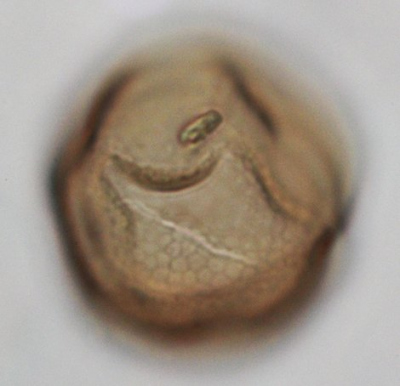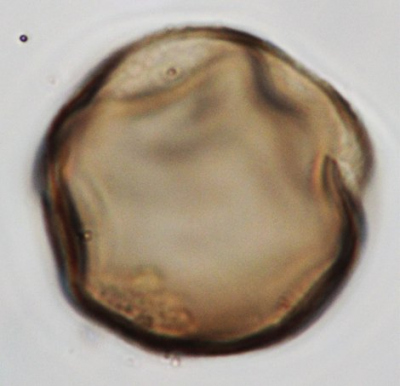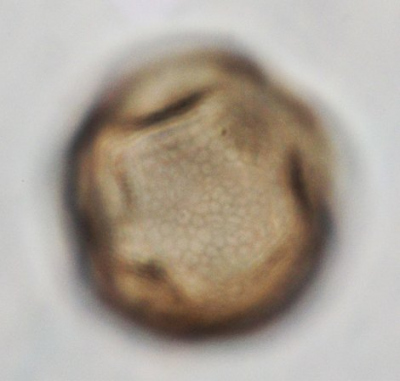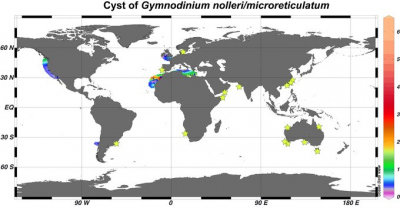Die Inhalte dieser Seite sind leider nicht auf Deutsch verfügbar.
Seitenpfad:
- Modern Dinocyst Key
- brown cysts
- round brown with septa, reticulation, double wall
- reticulate cysts
- Cyst of Gymnodinium nolleri
Cyst of Gymnodinium nolleri
Zonneveld, K.A.F. and Pospelova V. (2015). A determination key for modern dinoflagellate cysts. Palynology 39 (3), 387- 409.

dorsal view
photo: Karin Zonneveld
photo: Karin Zonneveld

cross section
photo: Karin Zonneveld
photo: Karin Zonneveld

ventral view
photo: Karin Zonneveld
photo: Karin Zonneveld
Field characteristics
Cyst of Gymnodinium nolleri Ellegaard and Moestrup, 1999
Field characteristics:
Spherical cysts that are reddish brown in colour. Cyst surface is covered with four- to seven-sided polygons, each measured at ~0.3 – 1.9 µm in maximal dimension. Sulcus is marked by rows of finer polygons, which are more regular in size and shape. Cingulum is demarcated by two double rows of vesicles, sulcus, and acrobase by one row. Tree (2-4) uneven rows of vesicles of 0.45 – 2.3 µm maximal dimension present within the cingulum.
Dimensions: Cyst body diameter: 28 – 38 µm. Ellegaard and Moestrup, 1999
Cyst theca relationship: Ellegaard and Moestrup, 1999
Comparison with other species:
This species can be distinguished from cysts of G. catenatum and G. microreticulatum by its smaller size, cingulum that is larger that 25% of the cyst body and its archeopyle that is usually positioned along the cingulum.
Field characteristics:
Spherical cysts that are reddish brown in colour. Cyst surface is covered with four- to seven-sided polygons, each measured at ~0.3 – 1.9 µm in maximal dimension. Sulcus is marked by rows of finer polygons, which are more regular in size and shape. Cingulum is demarcated by two double rows of vesicles, sulcus, and acrobase by one row. Tree (2-4) uneven rows of vesicles of 0.45 – 2.3 µm maximal dimension present within the cingulum.
Dimensions: Cyst body diameter: 28 – 38 µm. Ellegaard and Moestrup, 1999
Cyst theca relationship: Ellegaard and Moestrup, 1999
Comparison with other species:
This species can be distinguished from cysts of G. catenatum and G. microreticulatum by its smaller size, cingulum that is larger that 25% of the cyst body and its archeopyle that is usually positioned along the cingulum.
Geographic distribution
Geographic distribution based on :
Zonneveld et al., 2013. Atlas of modern dinoflagellate cyst distribution based on 2405 datapoints. Review of Palaeobotany and Palynology, v. 191, 1-197
Gymnodinium nolleri and Gymnodinium microreticulatum is observed in coastal sites of temperate to sub-tropical, oligotrophic to mesotrophic regions which are full marine and have bottom waters which are moderately to well ventilated.
Zonneveld et al., 2013. Atlas of modern dinoflagellate cyst distribution based on 2405 datapoints. Review of Palaeobotany and Palynology, v. 191, 1-197
Gymnodinium nolleri and Gymnodinium microreticulatum is observed in coastal sites of temperate to sub-tropical, oligotrophic to mesotrophic regions which are full marine and have bottom waters which are moderately to well ventilated.

Distribution:
Cysts of Gymnodinium nolleri/microreticulatum are observed in coastal sediments from temperate to sub-tropical regions of the eastern Atlantic Ocean and adjacent seas such the Mediterranean Sea, and the eastern Pacific. Highest abundances up to 6% occur off NW Africa.
Environmental parameters:
SST: 8.0 - 28.7°C (winter - summer) and SST > 14.0°C in summer. Exception is formed by one site in the northeastern Pacific where SST: -1.3, -0.8, 4.4 and -0.8°C (winter, spring, summer, autumn). SSS: 31.2 - 38.8 (winter - summer) except for one northeastern Pacific site where SSS: 26.8 in summer. [P]: 0.08 - 1.1 μmol/l, [N]: 0.18 - 6.95 μmol/l, chlorophyll-a: 0.1 - 15.9 ml/l, bottom water [O2]: 1.1 - 6.1 ml/l.
Abundances >2% occur when SST: 24.2 - 28.7°C (winter - summer). Highest relative abundances are observed oligotrophic/mesotrophic regions where bottom waters are moderately to well ventilated.
Comparison with other records:
Cysts of G. nolleri/microreticulatum have additionally been registered from coastal sites of the Skagerrak (Ellegaard and Moestrup, 1999; Harland and Nordberg, 2011), the western South Atlantic, the East China Sea and South China Sea, the Arabian Sea and around Australia/Tasmania (Bolch and Reynolds, 2002). A seasonal distribution study in Lisbon Bay (Portugal) documents that production occurs mainly in winter/early spring (Ribeiro and Amorim, 2008).
Cysts of Gymnodinium nolleri/microreticulatum are observed in coastal sediments from temperate to sub-tropical regions of the eastern Atlantic Ocean and adjacent seas such the Mediterranean Sea, and the eastern Pacific. Highest abundances up to 6% occur off NW Africa.
Environmental parameters:
SST: 8.0 - 28.7°C (winter - summer) and SST > 14.0°C in summer. Exception is formed by one site in the northeastern Pacific where SST: -1.3, -0.8, 4.4 and -0.8°C (winter, spring, summer, autumn). SSS: 31.2 - 38.8 (winter - summer) except for one northeastern Pacific site where SSS: 26.8 in summer. [P]: 0.08 - 1.1 μmol/l, [N]: 0.18 - 6.95 μmol/l, chlorophyll-a: 0.1 - 15.9 ml/l, bottom water [O2]: 1.1 - 6.1 ml/l.
Abundances >2% occur when SST: 24.2 - 28.7°C (winter - summer). Highest relative abundances are observed oligotrophic/mesotrophic regions where bottom waters are moderately to well ventilated.
Comparison with other records:
Cysts of G. nolleri/microreticulatum have additionally been registered from coastal sites of the Skagerrak (Ellegaard and Moestrup, 1999; Harland and Nordberg, 2011), the western South Atlantic, the East China Sea and South China Sea, the Arabian Sea and around Australia/Tasmania (Bolch and Reynolds, 2002). A seasonal distribution study in Lisbon Bay (Portugal) documents that production occurs mainly in winter/early spring (Ribeiro and Amorim, 2008).


